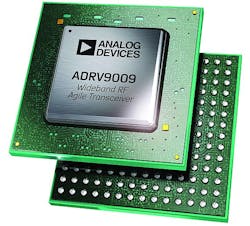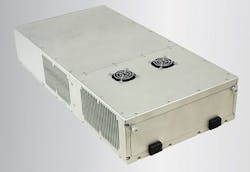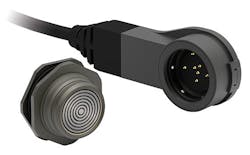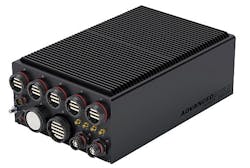2018 Intelligent Aerospace Technology Innovation Awards announced for aerospace and defense industry
NASHUA, N.H. – Military & Aerospace Electronics and Intelligent Aerospace today announced their 2018 Technology Innovation Awards to recognize companies offering substantial military, aerospace, and avionics design solutions.
Awards are in three tiers -- ranging from platinum, the highest, to the gold awards, and finally to the silver awards -- and are based on the recommendations of an independent panel of industry judges.
Platinum awards
The ATmegaS64M1 AVR microcontroller (MCU) from Microchip Technology Inc. in Chandler, Ariz., brings the AVR core with CAN databus capabilities to the aerospace industry. It is designed for enhanced radiation, extended temperatures, and increased reliability in critical aerospace applications, and comes with CAN controller, power stage controller, A/D and D/A controller, and analog comparators.
The ADRV9008/9 from Analog Devices in Norwood, Mass., is an integrated, radio frequency (RF) agile transceiver offering dual transmitters and receivers, integrated synthesizers, and digital signal processing. With a turning range from 75 MHz to 6 GHz, it offers wide bandwidth and high performance in single-chip TDD solution for communications, aerospace and defense, and electronic test & measurement applications.
The HSR40 high-speed network-attached storage (NAS) data recorder from the Curtiss-Wright Corp. Defense Solutions Division in Ashburn, Va., offers 40 Gigabit Ethernet handling the incoming data, with dual Xeon D processors and two built-in 40 Gigabit Ethernet interfaces. The processors can absorb the incoming data and redirect it to the persistent storage media, using third-generation PCI Express. Data pipelines over the backplane to the PCI Express-based non-volatile memory express (NVMe) solid-sate drives. Drives are installed onto removable memory blades, each with a maximum capacity of 32 terabytes, allowing for quick offloading of data for post mission analysis.
The LP360 rugged connector from Fischer Connectors in St-Prex, Switzerland, is for dismounted soldier systems, to enable foot soldiers to share information in real time. It connects and powers electronic devices body-worn by soldiers, and is an integral part of the Fischer intelligent vest, based on a shared data and power bus with wiring on the inside, one central battery for all, and connectors that work as a hub interface at strategically chosen locations.
The ATS-6100 WFT wire fault test and measurement system from Astronics Test Systems Inc. in East Aurora, N.Y., is designed to detect existing and potential wire faults and help extend the life of aging military or civil aircraft, ships, ground vehicles, and other high-vibration equipment where operational failure would be catastrophic. It detects hard and soft faults in a handheld, self-contained tablet, and eliminates the need to terminate the opposite end of the cable for testing, limiting human interaction and leaving cables undisturbed in the system.
The S402-SW Tiger from General Micro Systems in Rancho Cucamonga, Calif., is a mobile battlefield data center that provides server-class performance in a ruggedized, conduction-cooled system. Developed for the U.S. Army's Product Manager Mine Resistant Ambush Protected Vehicle Systems (PdM MRAP VS) the S402-LC/SW is sealed and operates in temperatures from -40 to 85 degrees Celsius with no fans required.
The VPX Backplane Probe Card Test Fixture from Elma Electronic in Fremont, Calif., enables characterization of differential VPX backplane channels between any two points on any 3U or 6U VPX backplane. It was designed for use on backplanes intended to support high speed signaling protocols such as PCI Express 2.1, InfiniBand DDR, Serial Rapid IO 2.2, PCI Express 3.0, Ethernet 10GBASE-KR, InfiniBand QDR, or InfiniBand FDR. The platform comprises three elements: a set of probe cards, a mechanical test fixture and a calibration card.
The TRRUST-Stor VPX Radiation-Tolerant Solid-State Drive from Mercury Systems in Andover, Mass., is a commercial solid-state drive (SSD) engineered for harsh operating environments using SpaceVPX standards. Although designed for commercial satellite applications, the device also can adapt to other applications where radiation exposure may occur, including high-altitude aircraft, airborne weapons, and mission-critical ground computing systems. TRRUST-Stor VPX RT SSD includes advanced BuiltSECURE error-correction algorithms paired with large geometry industrial-grade single-level cell (SLC) NAND flash memory.
Gold awards
SystemLink from National Instruments Corp. in Austin, Texas, is software that enables engineering teams to connect, manage, and optimize automated test and measurement systems. SystemLink improves operational efficiency and system uptime by providing a centralized web application for automating tasks such as systems deployment and management, test monitoring, and data analysis and reporting. SystemLink improves configuration compliance by discovering system settings and parameters and enabling remote configuration and diagnostics functions.
The Gallium Nitride (GaN) field effect transistor (FET) power supply solution from Renesas Electronics Corp. in Tokyo comprises the Intersil ISL70040SEH GaN FET driver and ISL70023SEH and ISL70024SEH GaN FETs to provide power to ferrite switch drivers, motor control driver circuits, heater control modules, embedded command modules, 100- and 28-volt power conditioning, and redundancy switching systems in satellites and launch vehicles.
The CTA803 AC-DC power supply from Aegis Power Systems Inc. in Murphy, N.C., is for low size, weight, and power (SWaP) applications for advanced military armored vehicles. It is housed in a water-tight enclosure and designed to meet MIL-STD-810F environmental standards, EMI requirements of MIL-STD-461F, and the 28-volt vehicle requirements of MIL-STD-1275E. It weighs 115 pounds and can accommodate U.S. Army counter-UAS technology needs.
The SR429/4D NEXSYS ARINC 429 Multi-bit Decoder from Applied Avionics Inc. in Fort Worth, Texas, can provide a binary decode of several data bits from one ARINC 429 data label. The SR429/4D is configurable with either 2x4 or 3x8 decode capabilities in less than 1 cubic inch of space. It offers configuration options for ARINC transmission speed, discrete output type, handling of SDI bits, and parity checking. Optionally, the SR429/4D can be configured with fail-sense circuitry that can simultaneously monitor the operation of the signal converter.
The RACE0161 AV/Unmanned Driving Solution from Crystal Group Inc. in Hiawatha, Iowa, is a high-performance, rugged embedded autonomous vehicle computer that harnesses modern commercial off-the-shelf (COTS) components stabilized in a rugged, compact enclosure constructed of aircraft-grade aluminum to streamline and speed the development and deployment of safe, robust, and reliable autonomous and unmanned vehicles and systems. A turnkey system, it helps overcome common challenges related to power and thermal management, size and weight, reliability, harsh elements and extreme environments, and an upgrade path to accommodate future needs and technologies.
The D2D-34S ATR chassis from Atrenne Computing Solutions in Brockton, Mass., supports the development-to-deployment program (D2D) life cycle, maximizing use of COTS components for development and demonstration with upgradeability for deployment, for reduced risk, reduced schedule, and reduced costs. This approach allows the product to use the same platform to support customers through their program life cycle.
The QPD1025L 1800-Watt (P3dB) discrete gallium nitride on silicon carbide high electron mobility transistor power IC from Qorvo in Greensboro, N.C., is for identification friend-or-foe (IFF) systems, avionics, and test instrumentation. It operates from 1.0 to 1.1 GHz., and input prematch within the package results in ease of external board match and saves board space. The device is in an industry standard air cavity package, and can support CW and pulsed operations.
The ZM3 enterprise-class small-form-factor mission computer from Zmicro Inc. in San Diego is for space-constrained applications such as manned and unmanned airborne intelligence, surveillance, and reconnaissance. It is equipped with an NVIDIA Quadro P6000 graphics processing unit (GPU) accelerator, and comes in a rugged design that’s about the size of a shoebox and weighs nine pounds. This lightweight computer packs in a 16-Core Intel Xeon D processor, three PCI Express expansion slots, as many as two removable storage drives and double-wide COTS high-end graphics cards. It provides the capabilities of a rackmount server in a fraction of the size and weight.
Silver awards
The Modest3D software suite from Modest Tree in Halifax, Nova Scotia, is designed for the rapid creation of 3D and virtual reality training solutions. It includes the Modest3D Editor and Modest3D Xplorer content development tools. Modest3D Editor helps create advanced 3D applications for task training. Modest3D Xplorer helps create immersive product presentations rapidly, as well as realistic virtual reality training without coding.
Ready to make a purchase? Search the Military & Aerospace Electronics Buyer's Guide for companies, new products, press releases, and videos





